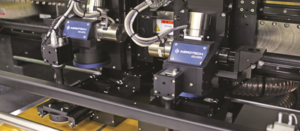
Positioning systems for micro production in the electronics industry
Fuerth, Germany, 18th October 2021 – At Productronica 2021, the world’s leading trade fair for the development and production of electronics, Aerotech will present its IGM (Integrated Granite Motion Systems) multi-axis positioning system with integrated galvo scanner and the latest Automation1 control platform. In addition, the manufacturer of high-performance motion control and positioning systems will showcase its comprehensive know-how in system solutions for the production of displays, LEDs and discrete components.

In the electronics industry, Aerotech is known for its high-precision motion solutions for critical applications, including manufacturing systems for micronano production, including system peripherals such as galvo scanners and control platforms. An IGM linear table with an AGV20HP galvo scanner and the new Automation1 control platform will be on display at the stand as a demo system. Aerotech launched the IGM (Integrated Granite Motion Systems) linear stages only three years ago as an alternative to conventional
positioning stages with granite substructures. They offer significantly higher rigidity and thus more flexibility in design. The customised linear stages have already proven themselves many times over as practical in a wide variety of applications.
“We will be using the IGM linear table to show live how an electroforming scanner and several movement axes can be precisely controlled simultaneously,” says Simon Smith, European Director Aerotech, specifying the upcoming trade fair appearance.
Galvo scanner with unlimited field of view

By synchronising with other movement axes, the galvo scanner shown can also process workpieces that are larger than its actual field of view – but the high processing quality is maintained. The proven IFOV function (Infinite Field of View) is available for improving the structural accuracy and for general error prevention, e.g. in “classic” stitching. Linear or rotational axes can be synchronised with the laser scanner in such a way that the scanner’s field of view can theoretically be extended to infinity.
New Automation1 version
“At the same time, we will also focus on the latest version of our control software “Automation1 – Precision Motion Control Platform”, we have installed it as a demo system for visitors to the fair.”
The Automation1 is much more than a mere “motion controller”, but also takes over the complete machine control with all components. The platform has its own software-based motion controller, which makes it easy to control different positioning systems as well as connected components.
Higher precision in electronics production

Applications in the electronics industry include automation systems, precision laser processes, and test and inspection processes. One example of the use of Aerotech positioning systems from electronics manufacturing is the production of OLED displays. Here, optimal synchronisation between scanner and servo table movement is particularly important. An additional advantage of controlling the scanner and servo table using a uniform hardware and software platform is that it minimises the dynamic errors of the servo stages. The execution of the cascading movements by means of a single integrated control algorithm enables the scanner to compensate for errors in the tracking of the servo stages in real time. In this way, OLED display manufacturers have little to no loss of accuracy compared to a separately controlled scanner system. “We will be happy to explain how such a system can be optimally synchronised to those interested in the trade at our trade fair stand. We are looking forward to numerous visitors and certainly many interesting discussions,” emphasises Simon Smith.

Simon Smith, European Director Aerotech in Ramsdell
 Instrumentation Monthly Test | Measurement | Control
Instrumentation Monthly Test | Measurement | Control



 Compact metal case with screw terminal block
Compact metal case with screw terminal block
 Combining Codeplay’s Acoran Platform Supporting SYCL™ and OpenCL™ With eSOL’s eMCOS RTOS Platform Will Empower Safety Critical Embedded Multicore Applications
Combining Codeplay’s Acoran Platform Supporting SYCL™ and OpenCL™ With eSOL’s eMCOS RTOS Platform Will Empower Safety Critical Embedded Multicore Applications  Heilind signs global agreement with Sensata-Crydom, expanding presence in solid state relay market. Heilind is now an authorised distributor for Sensata-Crydom – a leading solid state relay (SSR) manufacturer.
Heilind signs global agreement with Sensata-Crydom, expanding presence in solid state relay market. Heilind is now an authorised distributor for Sensata-Crydom – a leading solid state relay (SSR) manufacturer.

